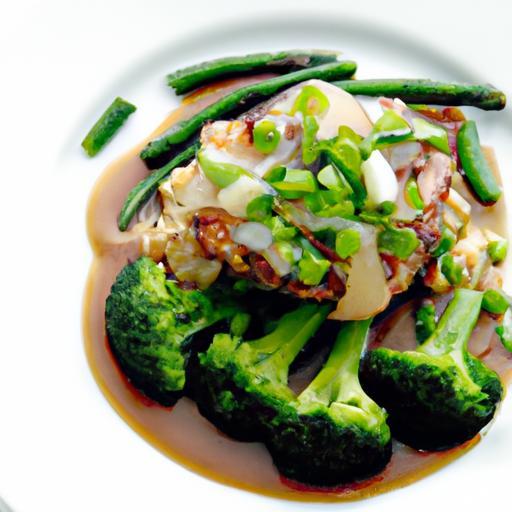Beneath every velvety béchamel and luxuriously rich velouté lies an unsung hero-the roux. This humble blend of flour and fat, often overshadowed by the sauces it births, is the secret architect crafting texture and depth in countless classic sauces. From the bustling kitchens of French bistros to modern culinary experiments, understanding the roux unlocks a world of flavor foundations. In this exploration, we peel back the layers on roux revealed, uncovering how this simple mixture serves as the essential base behind some of the most iconic sauces on the gastronomic stage.
Understanding Roux The Foundation of Flavor and Texture
Roux revealed the hidden magic in kitchens worldwide as the secret base behind classic sauces that define French, Cajun, and Creole cuisines. This humble blend of flour and fat unlocks a world of silky, rich textures and layers of flavor that elevate everything from béchamel to gumbo. Whether you are crafting a velvety white sauce or a deeply browned gravy, mastering the art of roux is the essential skill that chefs swear by to bring harmony and depth to your dishes.
Prep and Cook Time
- Preparation: 5 minutes
- Cooking: 15 minutes
- Total Time: 20 minutes
Yield
Approximately 1 cup of roux, enough for 4 servings of sauce or gravy.
Difficulty Level
Medium – Requires attention to timing and precise heat control for perfect outcomes.
Ingredients
- 1/2 cup unsalted butter (or rendered fat like bacon drippings or oil for alternative flavors)
- 1/2 cup all-purpose flour, sifted for lump-free blending
Instructions
- Melt the fat: In a heavy-bottomed saucepan, melt the butter or chosen fat over medium heat until fully liquefied but not browned.
- Add flour: Sprinkle the flour evenly into the fat. Immediately begin stirring using a wooden spoon or silicone spatula. This ensures even cooking and prevents lumps.
- Cook and monitor color: For a blonde roux, cook for about 3-5 minutes, stirring constantly until the roux turns pale golden with a nutty aroma. For a darker roux (used in Cajun dishes), continue cooking for 10-15 minutes, stirring carefully to avoid burning. Timing is critical-keep heat moderate.
- Test consistency: The mixture should be smooth and thick but fluid enough to drip slowly off your utensil. If it thickens too much, reduce heat and stir more slowly.
- Ready to use: Remove from heat immediately once the desired color and aroma develop. Add liquid (stock, milk, or broth) gradually to your roux while stirring to create a velvety base for your sauce.
Chef’s Tips for Success
- Use a heavy-bottom pan to ensure even heat distribution and avoid hotspots that burn the roux.
- Sifting your flour removes clumps, leading to smoother sauces and easier incorporation.
- Keep your stirring consistent; pausing too long risks scorching your roux.
- For gluten-free options, experiment with rice flour or chickpea flour-expect subtle changes in flavor and thickening ability.
- Make roux in bulk and refrigerate or freeze in portions to quickly jumpstart soups and sauces during busy cooking.
Choosing the Right Flour and Fat for Your Roux
Each flour and fat combination brings unique flavors and textures to the roux. Classic recipes utilize all-purpose flour paired with unsalted butter to maintain a neutral canvas that adapts well in delicate béchamel sauces or luscious cheese sauces. For Southern staples like gumbo, opt for neutral-tasting vegetable oil or rendered bacon fat, yielding a more robust, darker roux. Alternative flours like whole wheat or gluten-free variations subtly alter the roux’s texture and cooking time, encouraging creative culinary exploration.
Innovative Uses of Roux Beyond Classic Sauces
While traditionally the backbone of sauces such as velouté, espagnole, and mornay, roux’s versatility stretches far beyond these classics. Chefs today incorporate roux into no-knead breads to enrich crumb texture or blend it into creamy mashed potatoes for a silky finish. Roux-thickened gravies can pair beautifully with roasted vegetables, lending added depth. You can even reimagine roux as a crispy coating by cooking it to a darker stage, cooling it, then crumbling over salads or casseroles for unexpected crunch and umami flavor.

Serving Suggestions
Use this foundational roux as the launching point for luscious cheese sauces draped over seasonal vegetables, velvety gravy complementing roasted meats, or rich gumbo brimming with bold spices. Garnish finished dishes with fresh herbs like thyme or chives to add a pop of color and brightness. A light drizzle of browned butter or a sprinkling of toasted nuts can further enhance flavor complexity and texture.
| Nutrient | Amount per 2 Tbsp |
|---|---|
| Calories | 100 |
| Protein | 1g |
| Carbohydrates | 8g |
| Fat | 7g |
Looking to elevate your sauces further? Check our Classic French Sauce Recipes to build on this essential base. For a deep dive into culinary science behind flour thickening, visit The Culinary Institute of America.
Q&A
Q&A: Roux Revealed – The Secret Base Behind Classic Sauces
Q1: What exactly is a roux?
A roux is the magical blend of flour and fat, cooked together to create a smooth, thickening base for sauces, soups, and stews. Think of it as the unsung hero that transforms liquid into luscious, velvety delights.
Q2: Why is roux considered the backbone of classic sauces?
Roux provides both texture and body-it’s the culinary glue that holds a sauce together. Whether it’s the creamy béchamel clinging to cheese or a rich velouté enhancing chicken stock, roux builds that signature mouthfeel classic sauces are known for.
Q3: How do you make a roux?
It’s surprisingly simple: melt fat (usually butter) in a pan, whisk in equal parts flour, and cook gently while stirring. The cooking time depends on the desired color and flavor, from pale and mild to deep and nutty brown.
Q4: Can all fats be used for making roux?
While butter is traditional, chefs experiment with oils, animal fats, or even bacon drippings. Each fat lends its own flavor twist, making roux a versatile canvas for creativity.
Q5: What are the different types of roux?
French cuisine classifies roux by color: white (cooked briefly), blonde (a few minutes longer), and brown (deep brown with rich, nutty notes). Each type suits different sauces-white for béchamel, blonde for velouté, and brown for espagnole.
Q6: How does roux thicken sauces?
When flour and fat combine and cook, the starch granules in flour swell as they absorb liquid, creating a gelatinous network that thickens the sauce. This process turns thin stocks and milks into creamy, satisfying textures.
Q7: Are there any secrets to perfecting a roux?
Patience and attention are key. Stir constantly to avoid lumps or burning; watch as the color deepens to match your recipe’s needs. Remember, a darker roux intensifies flavor but thickens less.
Q8: Can roux be made ahead and stored?
Absolutely! Roux can be cooled and refrigerated or frozen for future use, making it a handy shortcut for busy kitchens craving classic sauce magic on demand.
Q9: Is roux used outside French cooking?
Yes, it’s a cornerstone in Cajun and Creole cuisines, lending depth to gumbo and étouffée. Roux’s global reach showcases its ability to elevate dishes across culinary traditions.
Q10: Why should home cooks master roux?
Understanding roux unlocks a world of texture and flavor. With this foundational skill, any cook can build sauces with confidence and sophistication, bringing restaurant-quality richness right into their own kitchens.
Final Thoughts
As we peel back the layers of culinary tradition, the roux stands revealed not just as a simple mixture of flour and fat, but as the silent architect behind a symphony of classic sauces. From the velvety embrace of béchamel to the rich depths of espagnole, this humble base carries the essence of flavor, texture, and technique across generations. Understanding the roux is more than mastering a recipe-it’s unlocking a gateway to endless kitchen creativity. So next time you whisk together that golden blend, remember: you’re stirring the very foundation of culinary artistry.


